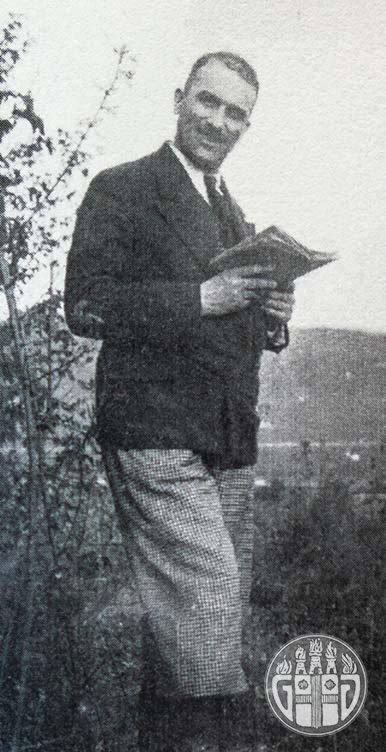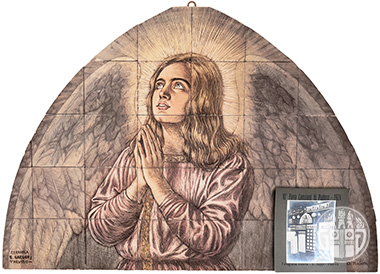The Artists' Hall was located in a large barn with a high ceiling that was divided longitudinally by a wall into two parts.
Entering by climbing a wooden staircase, one was met with something wonderful. The walls were adorned with ceramic panels of various sizes and supported by movable stands; the nails held plaster casts, frames, and terracotta objects.

Artists' Hall: Pietro Murani standing on the right, Prof. seated on the left. Carlini
The best known artists are Angelo Bonotto, Guido Cacciapuoti, Antonio Carlini, Alberto Martini, Mario Gregorj, Cesare Laurenti, Arturo Malossi, Arturo Martini, Piero Murani, Giuseppe Santomaso and Lugi Serena, Gino Rossi, Ugo Arvedi.

Room for tile decoration, kiln
Near the Hall there were active workshops for the modeling and painting of terracotta vases, carpentry for frames and supports, and wrought iron.
The artistic production was supervised by the entrepreneur and the artists who were not only collaborators but also external advisors, men of culture who shared their experiences with others and experimented with new techniques.
There were requests from individual clients such as preparation for the great national but also international exhibitions, which between the end of the nineteenth century and the first decades of the twentieth century were supported by painters, sculptors, workers and labourers.
The artist's signature is rarely present in the works of art and yet their name was also marked in full on the paper material, on the preparatory drawings, sometimes even with the date and with notes and such was the need to use every little space that you can see sheets drawn on both sides.
From the historical archive of the factory it is possible to obtain a large quantity of advertising material such as the advertising sign painted by Murani.

Girl painting
Advertising sign painted by Pietro Murani

Advertising sign painted by Pietro Murani
Angelo Bonotto
Painter and ceramist, he worked in the Fornace Guerra Gregorj between the nineteenth and twentieth centuries. He painted rural scenes, Venetian landscapes and subjects of neoclassical inspiration.
Together with the artist Piero Murani he had collaborated on the creation of a frieze in enamelled bricks depicting a Japanese dancer with the predominant tones of pale green.
Pietro Murani
(1879 - 1941)
.jpg)
Relief ceramic tile, Piero Murani, cm 16 x 16 cm
From his hands had arisen the graceful figures of 'liberty' art, which testify to a serene and harmonious vision of life: portraits, decorative panels, fantastic figurations to adorn palaces, halls and sacred buildings. His serene art is very distant from the incisive and revolutionary one of the young Arturo Martini.
He stood out for his harmonious interpretation of reality, comparable to Alphonse Mucha (1860-1939), the Bohemian artist who pioneered Art Nouveau.
Countless of his works are stored in the Sala Degli Artisti where he created various portraits and decorative panels exhibited in exhibitions such as that of Sacred Art in Turin in 1898, at the Universal Exhibition in Paris in 1900 and at the Brussels Exhibition in 1910.
From the drawings and paper drafts it is possible to notice his initials P.M. enclosed inside a graceful four-leaf clover that rarely appears in ceramic works.
An irreconcilable conflict with Arturo Martini, with whom he worked on the creation of two Christs in the same period, led him to abandon the furnace and continue his activity at Laurenti's studio in Venice, to the great regret of Gregorio Gregorj.
Cesare Laurenti
(1854 - 1936)

Profile of a woman
Cesare laurenti, 1903, 43 x 33 cm
One of his best-known works is characterized by its length of approximately one hundred and twenty by fifty-two meters. The polychrome ceramic frieze exhibited at the Venice Biennale in 1903 was purchased by the Municipality of Venice for the Gallery of Modern Art.
It portrays a series of characters taken from the masterpieces of Italian art, from those who were the first to free themselves from Byzantine dogmatism, such as Nicola Pisano, with a matron taken from the Birth of the Savior, in the bas-relief pulpit located in Pisa, in those of the Renaissance up to the Banquet of Anthony and Cleopatra painted by Giambattista Tiepolo.
This fantastic idea was first drawn up alongside Piero Murani in a long cartoon divided into 5 parts, with short, bold strokes in bright colours. The ceramic frieze has currently been located in the Mesola Castle in Ferrara since 1985, as a tribute to Laurenti.
Antonio Carlini
(1859 - 1945)
On behalf of Abbot Luigi Bailo, director of the Civic Museum of Treviso, he reproduced the polychrome band of the Loggia dei Cavalieri. The reproduction of the magnificent frieze in life size was also greatly appreciated by the furnace, for which he created a similar one in smaller dimensions using the watercolor technique with splendid colors on matte paper.
Commissioned by Carlini, the furnace had supplied two splendid vases depicting scenes from the medieval world and its contribution was important during the fiftieth anniversary of the unification of Italy at the Rome exhibition in 1911, when a medieval environment was reconstructed in the Hall of Treviso dedicated to the Court of Love. The simple and elegant furnishings, adorned with ceramic works in the predominant colors of green and yellow and Carlini's frescoes on the walls, inspired by the various sequences from the Loggia dei Cavalieri.
Guido Cacciapuoti
(1892 - 1953)
Renowned Italian sculptor and ceramist, he created a vast series of notable ceramics that make up the Cacciapuoti porcelains. His artistic mastery in modeling porcelain sculptures was also highly appreciated by Fornace Guerra-Gregorj.
Together with Arturo Malossi he worked in the Artists' Room, modeling small animal figures with strong expressiveness. In 1915 he achieved great originality on the occasion of the Treviso Art exhibition, in which Gino Rossi, Arturo Martini and Arturo Malossi also collaborated.
Arturo Martini
(1889 - 1947)
.jpg)
Little Satyr
Ceramic Panel, Arturo Martini, 1910, 30 x 30 cm
Born in Treviso in 1889, he attended the School of Arts and Crafts where maestro Giorgio Martini, father of the famous Alberto, proved to be a valid guide.
He began to have a certain notoriety in the city environment and became a student of the prof. Antonio Carlini, who had his own studio in the city. Among those who glimpsed his talent, there was also Gregorio Gregorj who welcomed him into the furnace, where in the Hall of Artists he found a real school that used the study of the great classics and the knowledge of new artistic styles that allowed him to express his talent in a unique way.
Of the Futurists, he did not lack self-confidence: "Me and Michelangelo" states the young artist with a tone of superiority towards the graceful and harmonious art of Pietro Murani.
He tried his hand at creating tiles, decorated vases in which the Egyptian and Aztec influence was evident and he modeled large statues inspired by the classics.
In 1909 Gregorio Gregorj sent him at his own expense to study in Munich, which was then considered, along with Paris, the capital of European art. From the Bavarian period, for which he remained for about a year, he produced small tiles and stylized statuettes which he then sent to the ceramic factory.
Mario Gregorj
(1891 - 1973)

His first pictorial experiences date back to the beginning of the twentieth century when he experimented with new techniques together with other young artists. He had developed an important role in the artistic production of the ceramic factory. Having graduated in law in 1912, he lived discreetly alternating his professional activity as a lawyer and that of an artist. He cultivated a rather marked internal conflict if his father Gregorio, in a handwritten letter, complained about his son's aspiration to neglect his law degree to dedicate himself to art. Yet one cannot go against the will of a son who later decided to refine his artistic ability by moving to Rome where he specialized as a medal engraver at the Rome Mint.
Alpine in the First World War, he was in the exhausting period of the trenches. Someone wrote tragic notes like Giuseppe Ungaretti to overcome discouragement, Linda Saccomani, wife of Giorgio Gregorj, in the 1930s wrote a letter to the poet Clemente Rebora (1885-1957) to ask him for a Latin phrase to place next to a sundial that she wanted to make draw on the facade of a house in the countryside. He affably replied with the following words "... quam levis hora ruit pueri dum tempus habemus, eca ergo aeternas rite paremus opes ..." which were then represented in the sundial inspired by a fresco by Veronese, in the Villa Angaran delle Stelle.
The Furnace also has one of his important works which depicts archers and which is displayed as an ornament on the facade of one of the buildings.
Arturo Malossi
(1893 - 1967)

Angel
Arturo Malossi, polychrome ceramic panel of sacred art, Maiolica technique, 75x105 cm
Arturo Malossi also made a significant contribution to the kiln in the first decades of the century, with his decorated plates and his sacred art panels. His art is distinguished by simpler, linear features but later more accentuated during the last years of the establishment's activity by the metaphysical abstractionism of Giuseppe Santomaso.
Like the Cacciapuoti, Malossi dedicated himself to the stylized representation of exotic animals, creating one of his most important enamel panels in relief, exhibited in 1930 at the International Exhibition in Barcelona when the factory obtained the gold medal.
There are also notable works of sacred art, preferring figures of angels but with a modern touch. In 1940 Malossi began its collaboration with Piero Vaccari's Ceramica Vicentina and then with the Fontebasso Manifattura of Treviso and with the Ceramica d'Arte Trevigiana.
His technique was also characterized by graffiti and he sought new mixtures of enamels and color, experimenting with them in his creations.
His decorated plates were highly appreciated at the twenty-fourth Venice art exhibition in 1948 while his graffito refractory panels were admired at the thirty-first Venice art exhibition in 1962.
Giuseppe Santomaso
Giuseppe Santomaso remained in the Artists' Hall and had introduced a new style, a particular relief tile used for the cladding and decoration of buildings between the 1950s and 1960s. Santomaso's decorations were also used for large decorative panels in ceramic tiles with stylized and almost abstract designs such as the one for the covering of the back wall of the swimming pool of the motor ship "Augustus" launched by the Cantieri Navali of Trieste.
